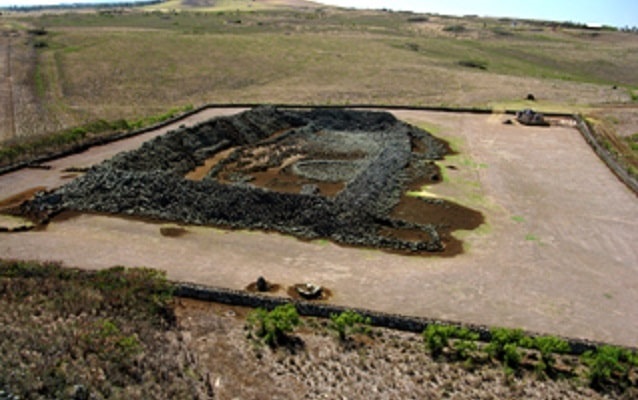Last updated: August 15, 2019
Place
Mo'okini Heiau

Photograph by Tom Benedict, Flickr
Mo'okini Heiau is located in Kohala Historical Sites State Monument near the town of Hawi on the Island of Hawai'i. It is one of the oldest and most sacred heiau (places of worship) in the Hawaiian Islands and is one of the first luakini heiau in the islands. Today, Mo'okini Heiau is considered a living spiritual temple and a sacred site to Native Hawaiians.
Tradition says that a temple was first built on the northernmost tip of the Island of Hawai'i sometime in the 5th century by the high priest Mo'okini. Later oral tradition says that the current heiau was built on the older temple between the 13th and 14th centuries by Pa'ao, a legendary priest from either Tahiti or Samoa who is said to have introduced the Hawaiians to human sacrifice, the walled heiau, and several types of kapu – the system of religious, political, and social laws that governed every aspect of daily life. Pa'ao was said to have lived near Mo'okini Heiau and founded a lineage of priests that served the ali'i 'ai moku(paramount chief) of the Island of Hawai'i through the early part of the 19th century.
Ancient Hawaiians had many types of heiau, each with their own distinct function and use by particular segments of society. Heiau ranged in size from single upright stones to massive and complex structures. Larger heiau were built by ali'i (chiefs), but the largest and most complex, the luakini heiau (sacrificial temple), could only be constructed and dedicated by an ali'i 'ai moku. Luakini heiau were reserved for rituals involving human or animal sacrifice and were generally dedicated to the war god Ku. Rituals performed at a luakini heiau highlighted the ali'i 'ai moku's spiritual, economic, political, and social control over his lands and his authority over the life and death of his people.
Mo'okini Heiau was built as a luakini heiau in the shape of a parallelogram - 267 feet long on the west, 250 feet on the east, 135 feet on the north, and 112 feet on the south. Stone walls made without any mortar using a dry stacking technique enclose the heiau. The walls are 10 feet wide at the base and are tapered both inside and out, varying in height from 7 to 14 feet. Hawaiian oral tradition says that the basalt rocks used to make the walls were passed hand to hand by thousands of men who formed a line from the Niuli'i area 10 miles to the east, to the site of the Mo'okini Heiau. The inside of the heiau contains a large stone platform in the northern end, with smaller platforms that once held thatched temple buildings scattered throughout the site. Outside of the heiau, on the north side, is the stone named Papa-nui-o-leka, on which human flesh was separated from bones after the body had been used in a ritual sacrifice. According to tradition, Mo'okini Heiau was the primary place of worship in the northern part of the Island of Hawai'i.
Mo'okini Heiau was active through the early part of the 19th century and was Kamehameha I's war temple, housing his family's war god Ku-ka-'ili-moku before the transfer of the god to Kamehameha's new war temple Pu'ukohola Heiau, 21 miles down the coast near Kawaihae. Kamehameha I's son and heir Liholiho also used Mo'okini Heiau. In 1819, after his father's death, Liholiho ended kapu
and abolished that part of the Hawaiian religion that depended on heiau. In spite of royal orders that they be destroyed, Mo'okini and several other large heiau were spared. It was believed that they had acquired mana (spiritual energy), which protected them against human destruction.
In 1978, Kahuna Nui (High Priestess) Leimomi Moʻokini Lum lifted the kapu (taboo) forbidding anyone but ali'i and kahuna from entering Mo'okini Heiau and also rededicated the heiau to the children of the land. In 1994, she again rededicated the heiau, this time to the children of the world. Visitors to the site often bring a flower or a lei to leave at the heiau as an offering of respect.
Approximately 2,000 feet to the south of Mo'okini Heiau, is the Kamehameha I Birthsite (Kapakai Royal Housing Complex). It was typical for an ali'i 'ai moku's housing complex to be near and associated with a luakini heiau and this is one of the few places in the Hawaiian Islands where historians know the exact location of a housing complex and its associated heiau. Over the centuries Kapakai served as the residence of ali'i 'ai moku when ceremonies were conducted in Mo'okini Heiau. Religious ceremonies lasted several days and nights and during this time, ali'i 'ai moku and high priests would leave the heiaufor short periods to return to Kapakai. Kamehameha I was born in the Kapakai Royal Housing Complex and later stayed there while conducting ceremonies in Mo'okini Heiau.
Mo'okini Heiau, a National Historic Landmark, is located on the northernmost point of the Island of Hawai'i in the Kohala Historical Sites State Monument, 5 miles southwest of Hawi, HI. Mo'okini Heiau is on Coral Reef Pl./Upolu Point Rd. off of Upolu Airport Rd. and Highway 270 (Akoni Pule Highway). Coral Reef Pl./Upolu Point Rd. is a rough dirt road and is best reached in vehicles with four-wheel drive. Kohala Historical Sites State Monument is open every day except Wednesday, from 9:00am to 8:00pm. There is no admission fee. For more information, visit the Kohala Hawaii website or call the Hawai'i State Parks, Hawai'i Island District Office at 808-961-9540.
